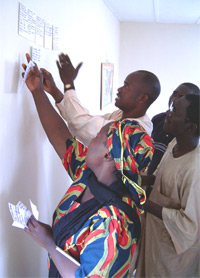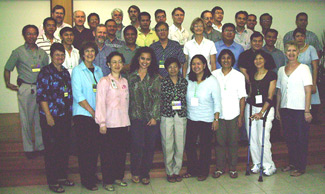|
|
When the majority world mission movement was emerging and we still spoke of “new sending countries,” a prevailing attitude was mildly perceptible: “We won’t make the mistakes that Western missionaries made because we know what it is like to be the receiving field of missionaries.” Yet, mistakes were made and who among us would dare suggest they are not still being made by us all? In one case, a national mission movement was challenged to provide adequate cross-cultural training for their outgoing missionaries and the response was “we have the Holy Spirit and that is enough.”
After a generation of workers plied the fields of mission, they are returning with the wisdom of praxis and national mission movements are enthusiastically promoting the development or improvement of pre-field training. Along with the wisdom of praxis, the dissemination of significant research and analysis has produced a broader recognition of the need for missionary training. Schools and training programs are not just budding, they are blooming in a colourful kaleidoscope of diversity in models, methods and practice. The question for many is, how can we do training that ensures the development of effective cross-cultural servants of God?
A Look Back—The Road of Specialized Missionary Training
Specialized missionary training schools are recent inventions. The task of training missionaries was mostly delegated to additional courses added to the curriculum of pastoral training schools; that is, seminaries, and later Bible schools. This approach is efficient, but tended to reinforce the prevailing attitude that all one needed to take to the field in way of training was the Bible and the Holy Spirit.
Along with the wisdom of praxis, the dissemination of significant research and analysis has produced a broader recognition of the need for missionary training.
Victorian England provided a context where the need to train women for missions emerged. The Faith mission movement embraced the service of women and Mrs. Tottenham established the YWCA Testing and Training Home in London, where in 1892 it became one of the first specialized missionary training schools. The purpose was to break down some of the barriers for single women impeding their reception into missionary agencies. From this home, Redcliffe College eventually emerged and now trains both men and women.![]()
Theological education entered the twentieth century with the Church dividing itself over such issues as the social gospel and the decline of a distinctly Christian cosmology, thus provoking the evangelical reaction known as the Bible School movement. During the first three decades of that century, several institutions focusing on missionary training emerged. Mount Hermon Missionary Training College (1911), Ridgelands Bible College (1919) and All Nations Missionary (Union) College are examples. These three eventually amalgamated (1971) and formed All Nations Christian College. Another example is the Sydney Missionary and Bible College which was established in 1916.
|
|
Sending agencies, on the other hand, saw a need for specialized training. The emergence of organizational training programs signaled the need for more specialized training. Examples of such are WEC International which began developing a series of Missionary Training Colleges, first in Glasgow and then in Tasmania, and now include a total six such colleges. Bethany Fellowship opened the school (1949) that continues under the name Bethany College of Mission.
As evangelicals began to rekindle a trust in higher theological education, a new-found interest in the social sciences led to the development of missiological training. The opening of the Fuller School of World Mission in the 1980s signaled a broad recognition of the need for missiological studies, and for deeper reflection and analysis of the missionary movement.
The idea of non-academic missionary training was also kindled in the hearts of some. The vision of Phil Armstrong (FEGC) and R.E. Thompson, along with support from Clyde Taylor (EFMA) spawned a new kind of training that led to the beginning of Missionary Internship (Now Missionary Training International). In its initial phase, missionary candidates spent seven months in a cross-cultural or urban internship and were coached through the process by experienced people. This was a novelty for missionary training and a program ahead of its time.
Toward Integral Missionary Training
It was only a matter of time before missionary agencies realized that trained missionaries required more than just an understanding of biblical/pastoral subjects. Early efforts to determine the areas of need in training were helpful, but not definitive. The ReMAP projects (Reducing Missionary Attrition Project and Retention of Missionaries and Practices) demonstrated empirically that specialized missionary training can make a difference in field worker longevity. These two projects studied the causes of attrition and factors leading to retention of field missionaries. Although ReMAP I (Reducing Attrition) did not clarify the role specialized missionary training plays in addressing attrition issues, the study helpfully clarified that the majority of preventable reasons of attrition relate almost entirely to character and spiritual issues and that participation in a dedicated missionary training program was one of the three identifiable factors which helped to reduce attrition. ReMAP II (the study of practices leading to the retention of field workers) demonstrated that dedicated missionary training played an important role in the longevity of workers.
It was only a matter of time before missionary agencies realized that trained missionaries required more than just an understanding of biblical/pastoral subjects.
After the findings of the first ReMAP project were published in the World Evangelical Alliance (WEA) publication Too Valuable to Lose (1997), agencies and schools began to take a serious look at addressing the critical training needs for today’s missionaries. Time and again the call was made to address the issues of spiritual and character formation in pre-field candidates. Along with this, a growing interest to provide new workers with “job ready” skills has led to the emergence of whole person, holistic or integral training approaches. ![]()
Integral training intentionally balances the whole program of study, redistributing allotted course hours and budget so that needed skills and character/spiritual qualities are not relegated to a role of peripheral learning, which may or may not occur. In this way, the knowledge components (cognitive learning) are merely instrumental and must lead to the intentional development of objectified skills and character/spiritual qualities. Knowledge is not an end in itself, neither is it assumed that an understanding of a subject equals an acquired skill or the formation of some character quality. Learning is transformed as programs embrace some more strategic learning contexts. Skills are learned by practicing. Character is transformed by creating self-awareness through the rub of significant relationships while living in community.
Missionary Training Programs and Resources
In 1995 Ray Windsor edited a WEA publication entitled the World Directory of Missionary Training Programmes providing a catalogue of over five hundred missionary training programs from around the world. Apart from contact information, the catalogue provides descriptions of the teaching staff, (Western, non-Western and cross-cultural experience), language of instruction, learning styles (percentage of formal and nonformal), courses offered (programs, degrees, etc.) and training ethos.
Creating this list was a monumental effort, but after Windsor’s initial effort, no one has taken up the challenge of maintaining this list. Today, another project based in England is attempting to develop a registry of training programs. The Evangelical Training Database is offered in English and Spanish and serves the evangelical community by providing a searchable list of training programs. Institutions can submit information and list degrees, diplomas, certificates or even individual courses.
The International Missionary Training Network (IMTN) has encouraged its members to use and register with this database and is working in cooperation with that ministry to provide searchable criteria identifying the formal, nonformal and informal elements in the training programs. Although the World Directory of Missionary Training Programmes provided the service of describing the teaching style, it was not really designed to distinguish between formal and non-formal training or between academic and integral (or holistic) training.
E-learning does not look like the well-weathered correspondence courses of old.
What the World Directory did was create an awareness of the rapidly expanding world of missionary training. The 1995 list accentuated the geographical proliferation of missionary training by listing sixty-four countries. Anecdotal evidence leads us to the conclusion that this number would be in the hundreds today. Some regions of the world enjoy very active networks focused on strengthening and multiplying missionary training centers. The COMIBAM movement in Latin America has a training coordinator, Dr. Omar Gava, who promotes holistic missionary training in the region. The diverse continent of Africa is challenged by language and cultural differences, but both Francophone and Anglophone countries offer missionary training for cross-cultural workers. Asia, Southeast Asia and China all rose to the challenge of sending missionaries and provide formal and nonformal missionary training. Bethany International’s “Go100” ministry has established a large network of missionary training schools in Africa and Asia. ![]()
Trends and Issues in Missionary Training
The world of training today now includes opportunities for distance learning. Most schools have developed distance learning initiatives or have looked seriously into doing so. The Internet provides a delivery vehicle that allows for an interactive and virtual classroom learning context. E-learning does not look like the well-weathered correspondence courses of old.
In-service training is emerging as the new development in missionary training. Motivated from a desire to provide the very best in education, and not merely to ease the burden of pre-field requirements, well-designed in-service training should provide new missionaries with information so that their urgently needed skills can be developed on the field. This will require the development of new training courses aimed at the areas of needed skills like cultural adaptation, language acquisition, and later, interpersonal skills, and eventually leadership skills. Recognizably, there is a relationship between in-service training and member care. In-service training is both life-long and initial entry in focus.
Even as missionary training has become more practical with a focus on skill development and critical spiritual/character formation, many missionaries continue to leave for their field appointments without receiving cross-cultural specific training. In-service training may assist in the initial development of needed skills and ongoing formation of character and spirituality, but there continues to be a need for sending agencies and churches to value and promote pre-field cross-cultural training. Evidence supports that this kind of training produces effective missionaries.
Available Resources
The IMTN seeks to promote integral missionary training by strengthening and encouraging the multiplication of holistic missionary training programs. The primary task of the IMTN is to resource trainers and this is done through the development of training materials, books, articles and courses in a variety of languages.
Printed materials are available through William Carey Library and many resources are available for download upon registration at www.TheIMTN.org. Training resources in languages other than English is slowed by the challenges of developing new materials or translating existing ones into strategic languages. Volunteers are encouraged to assist in this development. Online courses are now being offered in both English and Spanish. The first of these, Working Your Way to the Nations, is an immensely practical mobilization and preparatory tool for those in the process of following through on a missionary commitment.
The newest World Evangelical Alliance Mission Commission publication and training resource is Integral Ministry Training Design and Evaluation (2006) and can be previewed electronically at www.TheIMTN.org and is available for purchase from William Carey Library. This book provides the “how to” of developing an integral missionary training program, and includes valuable tools for evaluating and improving existing missionary training programs.



